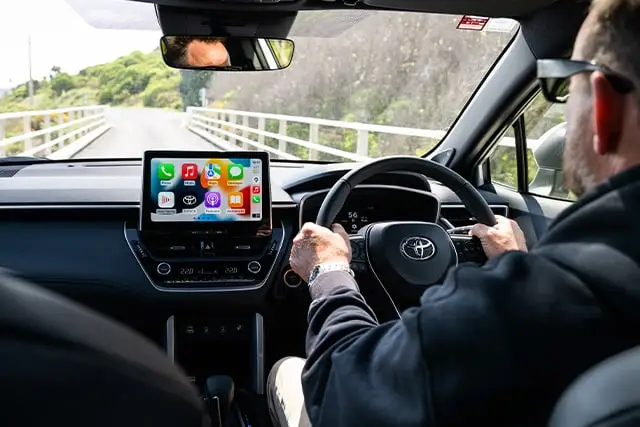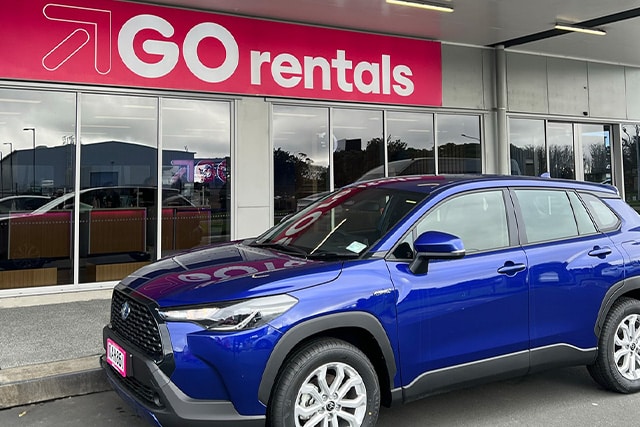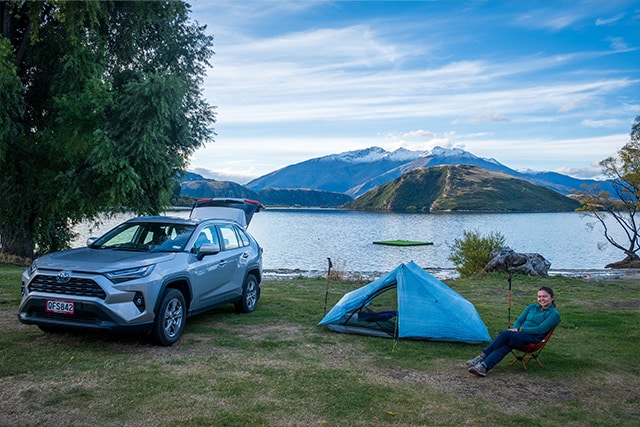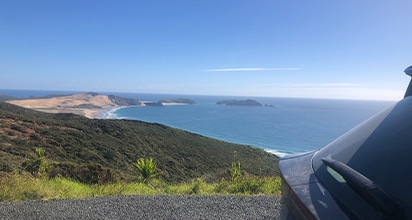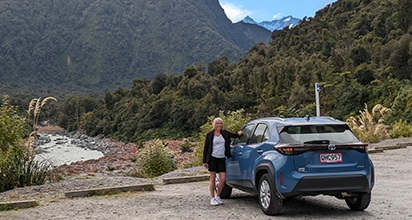When you don’t know the first thing about hybrid cars, the thought of driving one can be overwhelming. But it doesn’t need to be. These days, driving and renting a hybrid car couldn’t be easier – whether you’re looking for an eco-friendly rental for a weekend road trip or after a test drive to see if the hybrid life is for you, we’ll show you just how straightforward it can be. In this comprehensive guide to driving a hybrid car for first-timers, we’ll cover everything from:
- The key differences between a standard petrol car and a hybrid
- The different hybrid driving modes and how to use them to get the best fuel economy
- Our top tips for driving that benefit the environment (and your wallet)
- How to maximise the battery
- Other factors to consider
To make your first time driving hybrid as carefree as possible so that you can GO in confidence.
Key Takeaways
- A hybrid car works by using both a standard petrol engine and an electric motor powered by a hybrid battery, alternating between the two to maximise fuel efficiency
- By accelerating and braking gently and steadily, you can keep your hybrid car in EV mode for longer so that your hybrid vehicle can go further
- Planning your trip before you get in the car can help you avoid traffic jams and highly congested areas, reducing your need to break unexpectedly
- Regenerative braking will harvest more power for your battery to operate for longer
- Keep energy consumption – A/C use, wipers, lights – to a minimum where possible but keep in mind that this will inevitably be higher during colder or warmer seasons
- Maintaining your car and checking your manual to ensure the tyre pressure is what it should be will help your hybrid car run more efficiently
- Clean out anything in the boot or on the roof that doesn’t need to be there to reduce drag
How does a hybrid car work
A hybrid car works by using both a conventional petrol engine and an electric motor powered by a hybrid battery, unlike a standard car which only uses a petrol engine. The car will automatically switch between the petrol engine and the electric motor, or use a combination of both, depending on your driving scenario.
For example, when driving at low speeds, coasting or decelerating, a hybrid vehicle will generally use its electric motor. When the engine isn’t needed – like when you’re sitting still at the lights – it will shut off altogether.
You can keep your electric motor activated for longer by maintaining a slow and steady pace while driving – accelerating lightly and consistently. You can also generate more power by braking gently and early to help what’s called the regenerative braking system harvest more energy so that you can stay in EV mode as long as possible.
Planning your trip ahead to help you anticipate traffic jams and read the road is a good way to help avoid unnecessary or sharp braking, so you can go further for longer on the electric motor.
This ability for the hybrid car to seamlessly alternate between both power sources makes it incredibly fuel-efficient, as it will generally use the engine only for accelerating, ascending hills or when a bit of extra power is required. This means less petrol use and less time (and money) spent filling up.
Hybrid driving modes
Hybrid cars usually have four driving modes that you can switch between to get the best fuel economy:
- Normal: this is generally the mode your hybrid car will default to when you first start it. This mode automatically manages the most efficient use of both engine and battery
- EV mode: is when your car is powered by the battery only and runs near silent with no tailpipe emissions. This is the mode you’ll want to be in as much as possible for as long as possible when it makes sense, and you’ll usually use this for city driving and low-speeds. Things like regenerative braking and accelerating gently will keep your car operating in EV mode for longer, so always be on the lookout for ways to maintain your speed and control your braking
- ECO mode: reduces your A/C output for efficiency and the aggressive throttle response to limit harsh acceleration
- Power mode: boosts acceleration by using the hybrid battery to assist the petrol engine
Along with your four driving modes, there are also four shift lever positions:
- R(Reverse)
- N (Neutral)
- B (Engine Braking)
- D (Drive)
For everyday normal driving, D (drive) is usually fine. B (engine braking) might come in handy when you need to brake – like when you’re descending a steep hill. If you’re shifting to position B don’t forget to shift it back as you don’t want to use more fuel than necessary.
GO Rentals Hybrids Made Easy
At GO Rentals, our hybrid rental vehicles rely solely on the car battery and regenerative braking to recharge. When you drive these vehicles, you never need to worry about finding a charging station.
6 Tips for Hybrid Driving
1. Get familiar with the hybrid information display
This dash will help you learn how your driving impacts fuel economy and battery life, and you’ll be able to see when you’re in EV mode, so you can adapt your driving accordingly. It’ll also let you know how much energy has been used, and how much is left in your high-voltage battery. Keeping an eye on the dials and gauges will help you get the most range and fuel economy out of your hybrid car.
2. Keep the car in EV mode as much as possible
Keep your hybrid vehicle in EV mode as much as possible by controlling how much and how hard you accelerate. Slow, consistent and gentle acceleration will activate the electric battery and keep the car in EV mode for as long as possible, reducing your running cost and fuel consumption. Using ‘cruise control’ will also help maintain a steady speed.
3. Reap the harvest from regenerative braking
Similarly, your hybrid car will regenerate more power when you brake slowly and early on, allowing your car to operate in EV mode for longer. Before you start your trip, plan ahead by researching different routes and becoming familiar with the traffic conditions to avoid breaking unexpectedly and sharply.
4. (N)ever put the car in neutral when stationary
If you find yourself stuck in start-stop traffic, don’t put your car in neutral as electricity won’t be generated and the hybrid battery will discharge.
5. Recirculate where possible
Using the air con, headlights and wipers can use a lot of energy. Where possible, minimise this or use ‘climate control’ and hit the ‘recirculate’ button to reduce energy consumption.
6. Maintain upkeep
Make sure to check your tyre pressure regularly to ensure your tires are correctly inflated and your car is operating how it should. Clear out anything that doesn’t need to be in the boot or on the roof. This will help the car run smoothly and efficiently.
GO green with envy over hybrid efficiency
Because hybrid cars can switch between the petrol engine and electric motor – or combine both – they help reduce running costs and fuel consumption, meaning that they’re more fuel-efficient than normal cars. So whether you’re road tripping through New Zealand or taking a hybrid out for a test drive, you can do so knowing that you’re keeping the country green.
GO Rentals even allows you to offset these emissions even more via their GO Zero program. And, because you’re spending less on filling up, you’ve got more to spend on nice dinners, hiking tours and hotels. It’s a win-win.
How to maximise the battery
Learning how to monitor your information display and adjust your driving style will help you maximise your battery. When you’re driving around town or in city areas, accelerate to your required speed, ease off the accelerator and gently ease the accelerator on again. By doing this you activate E mode which will be indicated by the dashboard light, showing you that the engine has switched off and you are now using the electric battery.
Putting the car into ECO mode when you can’t drive at lower speeds will also improve efficiency and reduce the aggressive throttle response.
And finally, always try to maintain a consistent speed so you’re not breaking and accelerating unnecessarily, and therefore, using more fuel. Brake slowly and gently to allow the regenerative braking to harvest more power.
Other factors to consider
While we’ve given you all the tips to make your first hybrid ride as smooth as possible, be mindful that there are other factors to consider that will affect a car’s performance. In winter for example (June – August for New Zealand) your car will use more fuel as it warms up, and you’ll be more likely to have the heat on, as well as use the lights and wipers – all of which use electric power from the battery. Knowing this, keep an eye on your fuel consumption and don’t forget to fill up before heading on those icy road trips.
Our customers are revved up about hybrid rentals
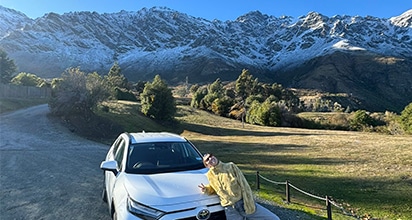
It was right at the beginning of our journey from Queenstown to Milford sounds – our celebratory trip for our 4 year anniversary. We were so happy to have a 4×4 and cruising around the South Island. Every stop warranted a photograph and the mountains were just incredible. Thanks so much for such an amazing trip travelling in pure style and luxury with fuel cost effective cars. We will use GO any opportunity around NZ.
Safire
Blue Betty, our trusted Yaris hybrid, seamlessly guided us through North Island’s wonders, coast to coast beaches, glow worm caves, towering kauri trees & tranquil hot pools. As we neared the tip where the Tasman & Pacific meet, Blue Betty proudly overlooked the Cape where we parked up & wandered down to the lighthouse. With her reliable navigation & smooth hybrid performance, every mile was an unforgettable adventure in New Zealand’s lush landscapes
Laurence
My family and I stopped to take in the epic landscape as the mist rolled in on the Milford Sound road, a beautiful wild place that everyone must visit at least once. We felt safe and capable in our GO Rentals Toyota Hybrid RAV4 vehicle and can’t wait to visit again soon! Thank you, Laurence & Elle – Nadi, Fiji.
Keith
The scenery all around Franz Josef was amazing but as we started to climb towards Fox we just had to keep stopping for photos! Bridget the Toyota Yaris SUV Hybrid is our new favourite car and she’s been so good to us so we just had to put her in the picture too! We couldn’t have done it without you Bridget – thank you, and GO Rentals
Get GOing in a Hybrid Rental
Driving a hybrid car may seem intimidating at first, but we hope we’ve broken it down and helped you see just how straightforward it can be. With these tips and tricks up your sleeve, you can GO confidently – whether you’re road-tripping through the New Zealand countryside or you’re test-driving around the city, we make it as easy as possible with rental car locations around New Zealand – most with 24 hours pick up and drop off – and plenty of cars to choose from in our hybrid car rental fleet.
You can also drive with peace of mind knowing we offer 24-hour roadside assistance and free basic insurance. If you need us, we’ll be there. So, here’s your sign to GO full steam ahead – book your hybrid rental faster than you can say ‘EV’.
Book a vehicle for this trip
We recommend:
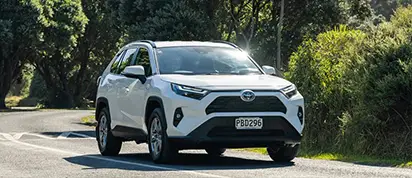
Intermediate 4×4 Hybrid
Toyota Rav4 AWD Hybrid
- Seats
- 5 seats
- Large Bags
- 3
- Small Bags
- 4
- Transmission
- Auto trans

